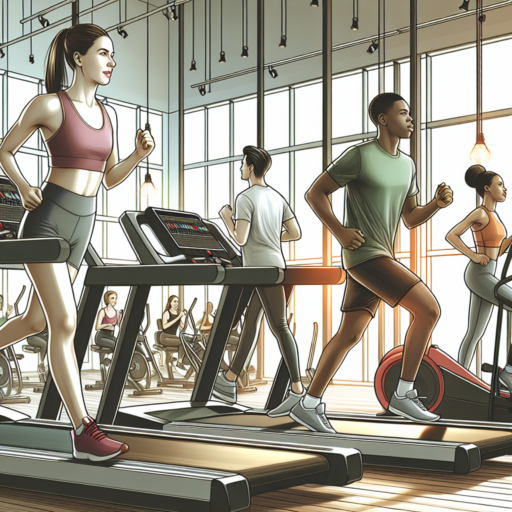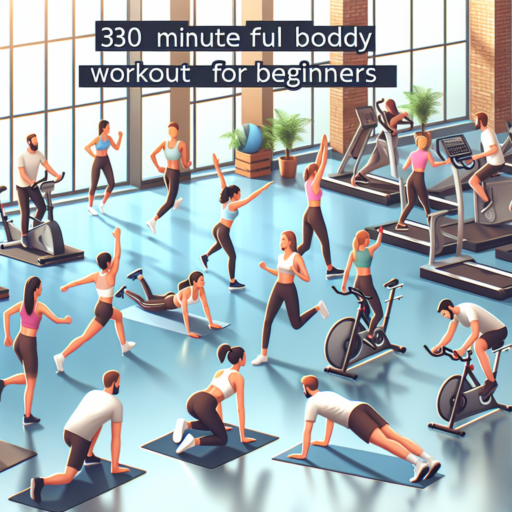Benefits of Running Indoors
Running indoors, often on treadmills, has gained significant popularity due to its convenience and the control it offers runners over their workout environment. Here are some of the key benefits of this exercise approach:
Control Over Workout Conditions
One of the primary advantages of running indoors is the level of control it offers over the workout conditions. Weather can no longer disrupt your training routine, allowing you to maintain consistency in your exercise regimen. Humidity, temperature, and wind are no longer factors that can affect your performance or motivation. This is particularly beneficial for those who are training for an event and need to follow a strict schedule.
Reduced Impact on Joints
Compared to running on hard concrete or uneven outdoor surfaces, indoor running surfaces, particularly treadmills, are designed to absorb impact more effectively. This reduced impact helps in minimizing the strain on your joints, including ankles, knees, and hips, potentially reducing the risk of injury and ensuring a smoother recovery after workouts. This makes indoor running a preferred choice for people with pre-existing joint issues or those recovering from injury.
Enhanced Safety and Convenience
- Safety: Running indoors eliminates risks associated with outdoor running such as traffic, poor visibility, or isolated routes. This is especially beneficial for individuals who prefer running during early morning hours or late at night.
- Convenience: Indoor running offers unmatched convenience. Not having to prepare for the outdoors means workouts can start immediately, and bathroom facilities are readily available. It also allows for multitasking, such as watching your favorite show or catching up on news, while completing your run.
Each of these benefits contributes to making running indoors an attractive option for maintaining fitness, regardless of external conditions or personal safety concerns.
How to Get Started with Indoor Running
Indoor running has become a popular exercise choice for many, thanks to its convenience and the controlled environment it offers. Whether you’re avoiding the outdoor elements or looking to supplement your outdoor training, getting started with indoor running requires some basic understanding and preparation. Here, we’ll guide you through the steps to embark on your indoor running journey, ensuring a smooth and beneficial experience.
Choosing the Right Equipment
One of the first steps in starting your indoor running routine is selecting the right treadmill. It’s important to look for a treadmill that suits your space, budget, and workout needs. Features to consider include speed range, incline settings, and cushioning to protect your joints. Additionally, investing in a pair of high-quality running shoes designed for indoor use can enhance your comfort and performance.
Setting Realistic Goals
As with any new exercise regimen, it’s crucial to set realistic and attainable goals. Whether you’re aiming to improve your cardiovascular health, lose weight, or build stamina, establishing clear objectives will help you stay motivated and track your progress. Begin with short, manageable runs and gradually increase the duration and intensity as your fitness improves. Remember, consistency is key to reaping the benefits of indoor running.
Creating a Balanced Routine
To maximize the benefits of indoor running and prevent injury, it’s essential to incorporate variety into your routine. Alternating between different types of workouts, such as interval training, long-distance runs, and speed work, can keep your sessions engaging and challenging. Additionally, complementing your running with strength training and flexibility exercises will enhance your overall performance and reduce the risk of injury.
Indoor Running vs. Outdoor Running: What’s the Difference?
Comparing indoor running to outdoor running reveals a range of contrasts that affect a runner’s experience, health impacts, and performance outcomes. At the core, the choice between treadmills and the trails may come down to personal preference, but understanding the distinctions can help runners make informed decisions about their training routines.
Environmental Conditions and Terrain
One of the most noticeable differences is the variation in environmental conditions and terrain. Outdoor running offers changing landscapes, inclines, and weather conditions, providing a dynamic and sometimes challenging experience. Conversely, indoor running on a treadmill offers control over pace and incline in a stable, weather-proof environment. This control can be particularly beneficial for beginners or those recovering from injury.
Impact on Joints and Muscles
Another consideration is the impact on the body. Running outdoors, especially on uneven terrains like trails, naturally strengthens the stabilizing muscles of the legs and core, promoting balance and injury prevention. However, it can also lead to higher impact on joints compared to the cushioned surface of a treadmill. Indoor running may reduce the risk of stress injuries but could potentially lead to underdevelopment of those important stabilizing muscles due to the uniformity of the surface.
Mental and Emotional Effects
The mental and emotional effects of running in different environments should not be underestimated. Many runners find the variability and scenic views of outdoor running mentally stimulating and stress-relieving. In comparison, indoor running provides an opportunity for focused mental training without external distractions, which could be advantageous for developing mental endurance. However, some may find the repetitive nature of treadmill running less engaging.
Must-Have Gear for Your Indoor Running Session
Embracing your indoor running session requires more than just motivation; it involves equipping yourself with the right gear to enhance your experience and performance. The significance of specific running gear can’t be overstated, as it not only contributes to comfort but also greatly reduces the risk of injuries. Hence, understanding and selecting the must-have gear is essential for any indoor runner, whether you’re a seasoned pro or just starting out.
Treadmills are the cornerstone of indoor running sessions. They allow for a controlled environment where you can adjust speed, incline, and even simulate outdoor running conditions. But to complement the treadmill, proper running shoes are paramount. Shoes designed specifically for running provide the necessary support and cushioning to absorb the impact, protecting your joints from the stress of repetitive motion. It is important to choose shoes based on your foot type and running style to ensure maximum comfort and efficiency.
Beyond the basic essentials, wearing the right apparel plays a crucial role in your running routine. Opt for lightweight, breathable fabrics that wick away sweat, keeping you dry and comfortable throughout your workout. Additionally, the importance of a good pair of headphones cannot be underestimated for those who rely on music or podcasts to stay motivated. Look for options that are sweat-resistant and have a secure fit to avoid constant readjustments during your run.
Creating an Effective Indoor Running Routine
Developing a successful indoor running routine can transform your fitness journey, offering a weather-proof and convenient alternative to outdoor runs. The key lies in understanding the nuances that make indoor running distinct and beneficial. This journey starts with the foundation of effective planning and the integration of variety to prevent monotony and stimulate continuous progress.
Establish Your Goals and Plan Accordingly
Before lacing up your sneakers, take a moment to define what you hope to achieve with your indoor running routine. Whether it’s improving endurance, speed, or overall fitness, having clear objectives will guide your training decisions. Further, it’s imperative to gradually increase your running intensity and duration to avoid burnout and injuries. Incorporating interval training, for instance, can significantly boost your cardiovascular health and stamina.
Incorporate Variety
Indoor running doesn’t have to be monotonous. Breaking the monotony is crucial for maintaining motivation and ensuring holistic development. Employing various running workouts such as tempo runs, interval training, and long,easy runs can inject fun and challenge into your routine. Moreover, alternating between different indoor running surfaces and inclines can simulate the outdoor running experience and engage a wider range of muscle groups.
Tips to Stay Motivated for Indoor Running
Keeping motivation high for indoor running can sometimes feel like a chore. Yet, it’s crucial to remember that with the right mindset and approach, this activity can be as fulfilling as any outdoor counterpart. Below, you’ll find actionable tips to help you maintain your enthusiasm and commitment to your indoor running routine.
Create a Dedicated Space
One significant factor that affects motivation is your environment. Designate a specific area in your home for your indoor running. This could be a spare room or a corner in your living area where you set up your treadmill. Personalize this space with inspirational quotes, adequate lighting, and perhaps a fan for cooling. Making your running area inviting and comfortable can greatly increase your desire to use it regularly.
Set Clear Goals
Having clear, achievable goals is paramount for staying motivated. Decide what you want to accomplish with your indoor running sessions—be it improving your speed, endurance, or simply staying active. Use these goals to plan your workouts, setting realistic milestones to reach along the way. Tracking your progress against these goals not only keeps you focused but also provides a sense of accomplishment that fuels further motivation.
Incorporate Variety
Monotony is a motivation killer. Keep your indoor running routine exciting by changing up your workouts. You could alternate between interval training, steady-state runs, and tempo runs. Additionally, consider listening to upbeat music, engaging podcasts, or watching motivating videos while you run to make the time pass more enjoyably. Integrating these variations can make each run feel like a new adventure, sparking your motivation each time you lace up.
Best Indoor Running Tracks and Treadmill Workouts
Discovering the best indoor running tracks and treadmill workouts can transform your fitness routine, offering you varied and challenging ways to stay on top of your running game, come rain or shine. Indoor tracks, often overlooked, provide a fantastic opportunity to simulate outdoor running conditions in a controlled environment. On the other hand, treadmill workouts are not just about running at a constant pace; they can be incredibly diverse, involving intervals, inclines, and even strength training exercises to keep your sessions engaging and effective.
When exploring indoor running tracks, look for facilities that offer a standard 200-meter lap length to align closely with outdoor running. These tracks sometimes feature banked turns to help reduce the risk of injury and mimic the outdoor experience even more closely. Additionally, various surfaces, such as synthetic or rubber, can offer different levels of cushioning and resistance, contributing to a more versatile training session.
Treadmill workouts, meanwhile, can be tailored to cater to a wide range of goals, whether you’re looking to improve your endurance, speed, or strength. Incorporating intervals into your treadmill routine is one way to elevate your cardio fitness, alternating between high-intensity sprints and low-intensity recovery periods. For those focusing on strength and endurance, adding incline to your runs can simulate hill workouts, significantly enhancing muscular strength and efficiency. To ensure progress, consider including a mix of these workouts throughout your training week.
Improving Your Running Technique Indoors
When the weather isn’t cooperating or you’re confined to the indoors, there’s no need to let your running technique suffer. Numerous strategies can be employed within the comfort of your home or the gym to enhance your running form. Focusing on these can lead to improvements in efficiency, speed, and reducing injury risks when you hit the outdoor trails again.
Utilize Treadmill Workouts to Your Advantage
Treadmills aren’t just for maintaining your cardio; they can be instrumental in refining your running technique. Pay close attention to your posture and foot placement while on the treadmill. Many runners find that running indoors helps them focus on maintaining a consistent pace and stride length, critical components of running efficiency. Additionally, playing with the treadmill’s incline settings can simulate outdoor conditions, helping to improve your strength and endurance.
Incorporate Strength Training and Plyometrics
While running technique indoors, don’t overlook the importance of strength training and plyometric exercises. These workouts are essential in building the muscle strength and power needed for an effective running stride. Focus on exercises that strengthen key running muscles—such as the glutes, hamstrings, and core—while also working on improving your explosive power through plyometric exercises. This dual approach will help you achieve a stronger push-off and better overall stability.
By adapting your indoor training routines to include these focus areas, you can use your time indoors wisely and come out with a noticeable improvement in your running technique. Engage directly with each element to see the best results, paying special attention to how each adjustment feels and impacts your running form. This targeted effort indoors will pave the way for smoother, more efficient runs when you’re back outside.
Nutrition and Hydration for Indoor Runners
Indoor running, whether on a treadmill or within the confines of a gym track, requires a specific approach to nutrition and hydration. Unlike outdoor running, where the environment and terrain vary, indoor running provides consistency in conditions that affect how runners should plan their nutrition and hydration strategies. It’s critical to understand the nuances to optimize performance and recovery.
Optimal Hydration Techniques
Hydration is a cornerstone of any runner’s performance, especially for those pounding the treadmill. Indoor environments can often be warmer and less ventilated, leading to increased sweat rates. Runners should aim to drink water regularly throughout the day, not just during their workouts. Implementing a hydration strategy, like consuming at least 500ml of water two hours before running and sipping on a water-electrolyte mix during prolonged sessions, can drastically reduce the risk of dehydration.
Strategic Nutrition Plans
Nutrition is equally paramount, with a focus on fueling the body for the demands of indoor running. A balanced diet rich in carbohydrates, proteins, and healthy fats provides the necessary energy for endurance and strength. Before a run, eating a light meal or snack, such as a banana or a small portion of oatmeal with berries, can offer the immediate energy required without weighing you down. Post-run, it’s vital to replenish energy stores with a combination of carbohydrates and proteins, like a quinoa salad with lean chicken or tofu, to aid in muscle recovery.
No se han encontrado productos.
Overcoming Common Indoor Running Challenges
Facing and overcoming common indoor running challenges is essential for maintaining an engaging and effective fitness routine. Indoor running, although convenient, poses unique hurdles that can impact performance and motivation. Recognizing these barriers and implementing strategies to overcome them can significantly enhance your indoor running experience.
Maintaining Motivation is one of the primary struggles faced by indoor runners. Without the varying landscapes and environmental stimuli that outdoor running offers, staying motivated on a treadmill can feel particularly challenging. One way to tackle this issue is by diversifying your running routine. Incorporating interval training, adjusting the incline, and varying speed can mimic outdoor conditions, making the run more mentally engaging and physically demanding.
Another challenge is Adapting to a Controlled Environment. Running indoors means less natural air resistance and a consistent temperature, which can affect your body’s adaptation and performance. To combat this, it’s important to sometimes slightly increase the treadmill’s incline to better simulate outdoor running conditions. Additionally, using a fan can introduce some air movement, helping to replicate the outdoor running experience more closely.
Lastly, Dealing with Spatial Restrictions is a hurdle for those who prefer the expansive openness of outdoor running. The confined space of running on a treadmill can feel limiting and claustrophobic to some. To alleviate this sensation, positioning your treadmill near a window or using virtual running apps that display scenic routes can help recreate the feeling of openness and freedom associated with outdoor running, making indoor sessions more enjoyable and less confining.




